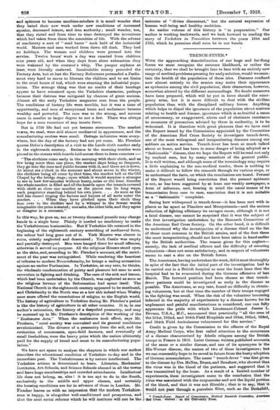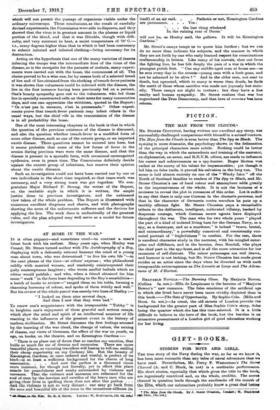TRENCH-FEVER.*
WITH the approaching demobilization of our huge and far-flung forces we must recognize the extreme likelihood, or rather the certainty, that we shall be brought face to face with an entirely new range of medical problems pressing for early solution, would we main- tain the health of the population of these isles. Diseases confined now almost entirely to the armies may make their appearance as epidemics among the civil population; their characters, however, somewhat altered by the different surroundings. No doubt measures have been prepared, which will be put in force should the emer- gency arise, but it is more difficult to deal with the civilian population than with the disciplined military forces. Anything which helps to dispel the ignorance of the population about matters relating to health and disease, ignorance which is so fruitful a cause of unnecessary, or exaggerated, alarm and of obstinate resistance to measures of precaution advised by those in authority, is to be welcomed. It is therefore with great pleasure that we have read the Report issued by the Commission appointed by the Committee of the American Red Cross Society to investigate trench-fever, one of the most widespread and incapacitating diseases among our soldiers on active service. Trench-fever has been so much talked about at home, and has been in some danger of being adopted as a "fashionable " disease, that we hope the Report will be read not only by medical men, but by many members of the general public. It is well written, and although some of the terminology may require a little explaining to the non-medical reader, there is nothing to make it difficult to follow the research through its various steps, or to understand the facts, on which the conclusions are based.- Perusal of the Report would bring conviction that the present epidemic is not, as has been suggested by at least one weekly newspaper, a form of influenza, and, bearing in mind the usual means of its transmission from case to case, conviction that it is not suitable as a " fashionable " complaint.
Seeing how widespread is trench-fever—it has been met with in places so far apart as Flanders and Mesopotamia—and the -serious reduction of fighting efficiency its ravages cause, although it is not a fatal disease, one cannot be surprised that it was the subject of the first investigation undertaken by the Research Committee of the American Red Cross Society. On the other hand, it is difficult to understand why the investigation of a disease third on the -list of those most common in the British armies, and of the first three the most incapacitating, should not have been taken in hand earlier by the British authorities. The reason given for this neglect— namely, the lack of medical officers and the difficulty of securing volunteers—does not seem satisfactory, and in respect of volunteers seems to cast a slur on the British forces.
The Americans, having undertaken the work, did it most thoroughly in spite of the fact that the initial part of the investigation had to be carried out in a British hospital so near the front lines that the hospital had to be evacuated during the German offensive of last March. The forward position had been chosen so that trench- fever patients could be investigated as early in the disease as possible. The Americans, at any rate, found no difficulty in obtain- ing volunteers, but at that time the number of their troops engaged in the fighting was small. When the risk of the volunteer becoming infected in the majority of experiments by a disease known for its unpleasant and painful manifestations is considered, one can fully appreciate the pride with which Lieutenant-Colonel James L. Bevans, U.S.A., M.C., announced that practically " all the men of the 1016t, 102nd, and 104th Field Hospitals and 101st, 102nd, 103rd, and 104th Field Ambulances volunteered for this service."
Credit is given by the Commission to the officers of the Royal Army Medical Corps, who first called attention to the occurrence of a disease characterized by febrile relapses among the British troops in France in 1915. Later German writers published account of the same or a similar disease, and one of its synonyms is the His-Werner disease, the names of two of these investigators ; but we can reasonably hope to be saved in future from the hasty adoption of German nomenclature. The name " trench-fever " was first given to the disease by Drs. MoNee, Brunt, and Renshaw, who showed that the virus was in the blood of the patients, and suggested that it was transmitted by the louse. As a result of a limited number Of experiments, these investigators came to the conclusion that the virus was associated with the corpuscular and not the liquid portion of the blood, and that it was not filtrable ; that is to say, that it would not •pads through a porcelain filter, such-as the Berkefeld, • Trench-Fever. Report of Commission, Medical Research Committee, Amities* -Red Cross. Orford : at the univenitY Frew.
which will not permit the passage of organisms visible under the ordinary- microscope. These conclusions, as the result of carefully devised experiments, the Commission were able to disprove, and they showed that the virus is in greatest amount in the plasma or liquid portion of the blood, and that it was filtrable, though with diffi- culty, and very resistant to heat, a moist temperature of 70° C.— i.e., many degrees higher than that to which it had been customary to submit infected and infested clothing—being necessary- for its destruction.
Acting on the hypothesis that one of the many varieties of inserts infesting the troops was the intermediate host of the virus of the disease, as is the mosquito for the parasite of malaria, many experi- ments were carried out with the louse, the commonest of all. The choice proved to be a wise one, for by means both of a selected breed of lice and of lice obtained from the clothing of trench-fever patients it was shown that volunteers could be infected with the disease, the lice in the first instance having been previously fed on a patient. One's hearty sympathy goes out to the volunteers, who fed these- lice inspeoiallyeonstructed cells on their arms for many consecutive days, and one can-appreciate the witticism, quoted in the Report : " Ce n'eet pas la morsure, c'est la promenade." Other experi- ments prove that trench-fever patients may infect others in the usual ways, but the •chief role in the transmission of the disease is in all probability the louse.
One of the most interesting chapters in the book is that in which the question of the previous existence of the disease is discussed, and also the question whether trench-fever is a modified form of• some other disease, such as one of the enterio group, or an imported exotic disease. These questions cannot be entered into here, but it seems probable that some of the low forms of fever in the armies during previous wars were the same disease, and that the disease is present in a sporadic form, with occasional unrecognized epidemics, even in peace time. The Commission definitely decide against the enteric group of infections, but reserve their opinion about the exotic diseases.
Such an investigation could not have been carried out by one or two individuals in the short time required, so that team-work was necessary, and a very strong team was got together. We con- gratulate Major Richard P. Strong, the writer of the Report, on the readable style in which it is written, the ample justice done to previous investigators, and the unbiassed view taken of the whole problem. The Report is illustrated with numerous excellent diagrams and charts, and with photographs showing the arms of the unfortunate sufferers and the devices for applying the lice. The work done is undoubtedly of the greatest value, and the plan adopted may well serve as a model for future investigators.











































 Previous page
Previous page